Debunking the top 10 vehicle tracking myths
Common vehicle tracking myths are "Big Brother is watching" or too time-consuming. We share the top 10 myths and explain why they're wrong.


The reasons for any misconceptions around GPS tracking or telematics are mostly due to a misunderstanding of the product. Common vehicle tracking myths range from how the devices “monitor” vehicles and drivers, to what the capabilities are, to the types of businesses where it’s needed.
These myths also range within an organization depending on the person’s role — a driver could have an exaggerated view of what gets tracked, an executive could have a misunderstanding on the costs, and a fleet manager could have a misplaced fear on how will it change their day to day.
Many of these myths have been debunked, with real applications of the technology solidifying evidence in the case for telematics.
Top 10 telematics and GPS tracking myths
1. Telematics Means Big Brother Is Watching
Telematics tracks information about a vehicle and how you use it. It’s important to not get vehicle telematics mixed up with some of the cell phone GPS tracking systems out there, where drivers must download an app onto their phone. Those types of systems mean the driver’s cell phone is what is actually getting tracked, not the vehicle. While these systems provide “dots on a map,” they don’t tell the whole story, and your drivers would probably agree.
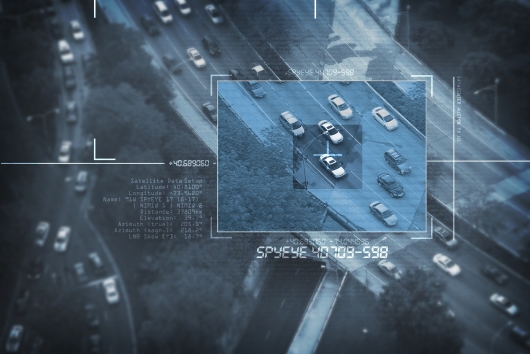
Commercial vehicle tracking with telematics is not spying.
With vehicle telematics, there are tiers of the technology depending on the need of the business. It ranges from a simple GPS tracker that will just tell you where a vehicle is located, all the way to a robust telematics system that allows you to monitor vehicle health, manage productivity, improve fuel efficiency, stay compliant with government regulations, and keep drivers safe.
An open platform telematics solution such as Geotab will give you access to your data for integration with other management systems and automation, as well as an online Marketplace of business-focused application apps and Add-Ons.
So yes, theoretically, there’s a lot of information that could be potentially tracked. But any information used is all in the best interest of not just the business but the driver too. Getting into an accident could mean getting fired from your job after all.
If there’s a behavior that can mean lowering the risk of an accident, and therefore lowering the risk of losing a job, drivers are likely to be open to the feedback. In some cases, the information can even exonerate drivers when frivolous complaints come in. That means it’s important upon telematics rollout, executives and managers emphasize the role the technology will have in the safety of all drivers.
Besides, the vast majority of fleet managers aren’t interested in and don’t have time to watch each driver minute by minute. This is especially true for large fleets that might have hundreds or thousands of drivers. They are more concerned with using telematics data to help meet company goals, such as reducing fuel costs using fuel cards or minimizing the number of accidents.
In fact, some companies use telematics data to score and reward safe and fuel efficient driving performance — not just bad. Read more about fleet gamification in this post.
Case study example: A mid-sized, mixed fleet that implemented a driver rewards program.
2. A Telematics Device Will Interfere With Performance of the Car or Void the Warranty
There is a myth that a telematics device will damage some electronics in the car and possibly even void the manufacturer’s warranty. In the U.S., the Moss Magnuson Warranty Act of 1975 specifically prohibits manufacturers from voiding the warranty due to aftermarket additions to the vehicle. So, as long as proof of defect can be attributed to the car manufacturer, then your warranty is valid and enforceable regardless of whether or not you attached an aftermarket part. Plus, the device is in no way changing the vehicle mechanically — think of it more as an engine data viewer and translator. It can see engine performance information and send that information back in a tangible way for use as business intelligence.
In regards to reliability, it is true that a device will draw energy from a car’s battery, however the usage is very low. The Geotab GO device goes into sleep mode when the vehicle is turned off and will only draw 2.5 mA of current. A typical car battery has a capacity of 50 Ah, which means it will take over two years before the device can come close to depleting the battery. So as long as you’re driving the vehicle frequently, it won’t matter because the battery will recharge. The GO device is smart enough to turn itself off if a vehicle is left for months at a time without charging the battery.
To minimize performance risks, it’s a good idea to pick a reputable telematics company that invests a significant portion of their revenue into research and development. Geotab has spent, and continues to spend, considerable time to ensure the product cannot cause harm to your vehicle.
Case study example: A fleet that has only seen improved performance with fewer accidents and more consistent maintenance.
3. Drivers Will Lose Driving Time
It’s common to believe that telematics will require more effort and input from your drivers because they’ll have to play with the device or log information. That’s not true.
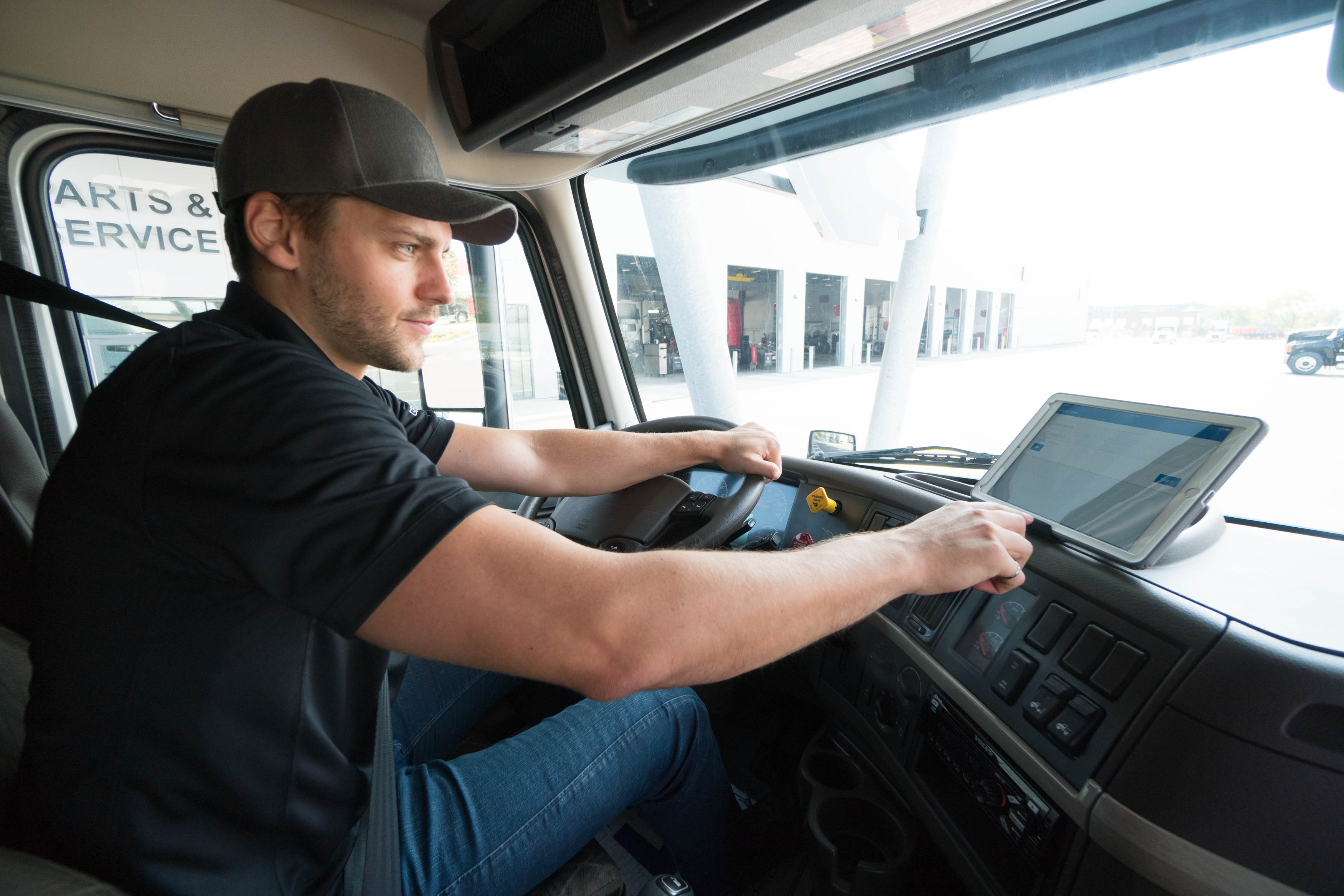
Electronic logging devices (ELDs) save drivers time previously spent on filling out paper logs.
When a driver turns on the ignition, a device automatically starts collecting and transmitting data as needed. The only situation where a telematics device will require driver input is when the device is being used as an electronic logging device (ELD). And in that case, the system is replacing a paper log system, so the opposite is true with ELDs.
In the Federal Motor Carrier Safety Administration (FMCSA) final rule on ELDs, it mentions a report from George Washington University Regulatory Study Center that the transition from paper logs to ELDs will reduce the time spent complying with the Hours of Service (HOS) regulations by 68.33 million hours per year across the nearly 4 million drivers required to comply with HOS and the administrative personnel dealing with these as well. To put into figures, the FMCSA estimated the annual recordkeeping cost savings from the proposed rule to be about $705 per driver.
Outside of ELDs, fleets will find time savings in other ways, and often through better and easier recordkeeping, reduced paperwork, and more efficient routing and dispatching to jobs.
Case study example: A member-tailored approach to telematics access and uses.
4. I Don’t Need to Track Dots On a Map
The terms telematics and GPS devices are often used interchangeably, which has lead to the common assumption that telematics places “dots on a map.” That couldn’t be further from the truth.
A telematics device has GPS tracking capabilities, which many small businesses like taxi, lawn and maid services find helpful to quickly locate employees. This is telematics in its simplest form but has matured far beyond “dots on a map.” Though it is important to point out that not all companies selling devices have the ability to track other information like idle time or hard braking.
Maybe you don’t need to track dots on a map, but could your organization benefit from safe driving? What about a decrease in fuel costs? A telematics device allows you to track information like a driver’s speed, idle time, hard braking, and more. You can use it to optimize your fleet and reduce costs, keep vehicles on a regular preventive fleet maintenance schedule, predict battery failure ahead of time, make fuel tax reporting a breeze and more.
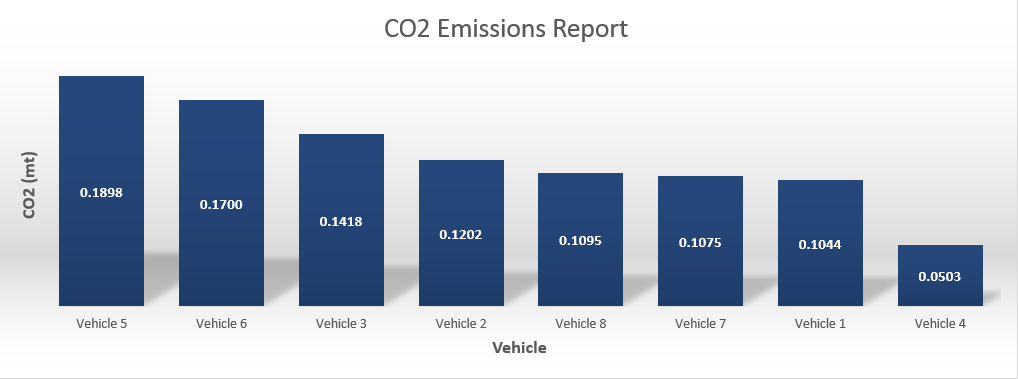
Sample CO2 Emissions report that tracks a fleet’s carbon footprint.
For example, here are some popular Geotab fleet management reports that can be generated with telematics data:
- Average Fuel Economy Report
- Dynamic Vehicle Maintenance Reminder
- CO2 Emissions Fleet Management Report
- Reports for ELDs and HOS compliance
Plus, you can analyze the reports to help in future route and schedule planning, or even to see that one needs to be modified immediately, which can help reduce gas costs and vehicle wear-and-tear. That also means less shop downtime, less paperwork, and less time and money spent on managing your fleet. That also means you can get a return on investment, and often pretty quickly.
Case study example: Mining company with mixed fleet that need a lot of custom reporting solutions.
5. Telematics Is Too Expensive
“Telematics is going to cost me thousands of dollars to implement,” is something we hear often from smaller businesses. Depending on fleet size, your needs, and the vendor you select, telematics can be as expensive as $1,000 per month for an enterprise-sized corporation or as affordable as $15 a month for a small business.
When looking at a telematics solution, you will have to compare vendors on hardware, software, and installation costs. At Geotab, our resellers offer a variety of different data plans depending on what the fleet is ready to manage, plus a seasonal plan. We offer a lower monthly cost-suspend option for seasonal vehicles since some businesses experience peaks during certain times of the year.
Secondly, a telematics device should be thought of as an investment, not an expense, and the ROI should be considered, such as how you’re recouping the cost of the service by using the software to tackle goals such as reducing fuel use and lowering maintenance costs.
In other words, if you could put $1 into telematics and it returned $2, would you care how much it costs? Before purchasing a solution, run a cost-benefit analysis. Estimate the amount of money a device could save you or make you and compare that to the costs. If you need data points for your analysis, ask experts in the field or start with a small pilot project on one vehicle.
Case study example: A nonprofit with only 12 vehicles
6. My Company Is Too Small to Use Telematics
The misconception is that telematics is only for large companies, but operations of any size with just one vehicle can benefit from a telematics device.
For example, a small cleaning company with three or four vehicles could benefit from GPS tracking. If an employee is at a work site and ran out of a certain cleaner, the operations manager or owner could send them to the location of the other cleaners instead of the office, if it means a shorter distance to go.
Or say a customer calls asking when a driver will arrive, and without disturbing the driver, the owner can give a near-exact time the driver will arrive based on where they are on the route.
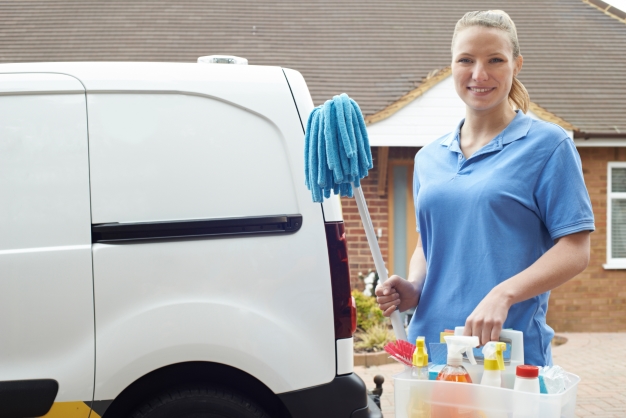
That same company could track how its employees use the vehicles. Maybe you give your employees a gas card and think they might be using the card to buy gas for their personal vehicles or their friends. When a card is used at a gas station, it will record where the device is at that time. If the data shows the car is 20 miles from where the card was swiped, then you know the driver is using the card inappropriately.
Case study example: A hardware distributor with just two trucks in fleet.
7. It Takes Too Much Time to Manage
From installing vehicle tracking devices to reporting and analyzing data, it’s understandable why there’s a misconception that it can be time consuming to manage telematics. The truth is that a telematics solution can be as time-intensive as you want it to be.
Starting with installation, it can sound like a complicated or technical process needing an expert. But this is not true. Not only are the latest GO products small and compact, but they are designed to make installation quick and easy. You just locate the OBD-II port in your vehicle, insert the device into the port and voila!
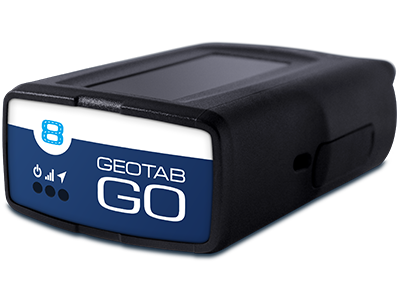
The Geotab GO device can be installed quickly and easily.
For data collected and looked at, the more time you spend on it, the more likely you are to see a positive ROI but many functions can be automated. For example, you can create alerts that are sent to your phone or inbox when a driver arrives at a certain location. You can create an alert when a driver has been involved in an accident. Small businesses needing simple alerts and automated reports can do so, thus adding no additional time to the day.
But the busier you are or larger your company becomes, the more critical a telematics solution becomes. It can uncover areas of waste in your operations. Some businesses are able to see that they actually have more vehicles than they need by getting a better look at vehicle utilization rates. Sure, someone had to spend time pulling reports and looking at the data, but fleets can save significantly on unused or underused assets, which are expensive to keep in a parking lot for no reason.
Case study example: Company that needed time spent on data analysis to reach safety goals.
8. Why Do I Need to Track Drivers when I Can Use Paper Logs and Service Cards?
Doing things the same old way is an easy habit to get stuck in. But you’ve probably changed other small things in your business over the years of your operations as you learned about new or different ways of doing business, new products, etc. The same is true when considering telematics. Look at the technology as a new thing that could potentially change your business for the better.

Say goodbye to paperwork. Automated tracking and notifications simplify management.
While it’s true that you can use paper logs and service call sheets to confirm work has been completed, sometimes these can get misplaced or key details forgotten. Furthermore, no one wants to get stuck doing paperwork when there is a simpler way to do it. Why not use the automated and customizable reports that Geotab offers to streamline service reports and payroll activities? Improve your customer service with more accurate job billing or faster response times. Consider all the features of telematics software and how each component could possibly change, for the positive, the way you do business.
Case study example: A service fleet that realized how disconnected their service network was once they implemented telematics.
9. I Trust My Employees, I Don’t Need to Track Them
You trust your employees and hire only the best quality. What could go wrong? This is a common myth that can get owners and managers into trouble. Not that employees aren’t trustworthy, but we all make mistakes. And for an employee, it wouldn’t be out of the ordinary to try to hide a mistake or cover it up.
To make our business better, we have to see the individual employees activity holistically through telematics. Only then will the opportunities like adding more drivers, removing drivers, changing routing or altering time of day for drivers, present themselves.
Plus, as mentioned before, telematics devices do not have to be used to monitor driving behavior. Some customers utilize the devices for a more basic use, such as security. If a vehicle (or expensive piece of equipment) is ever stolen, with the help of real-time GPS tracking, your chances of recovering these assets increase exponentially.
Additionally, since telematics devices can communicate with the vehicle’s engine control module (i.e. its computer), it is possible to pick up on potential vehicle problems via diagnostic trouble code alerts and perform preventive maintenance before these issues become bigger problems.
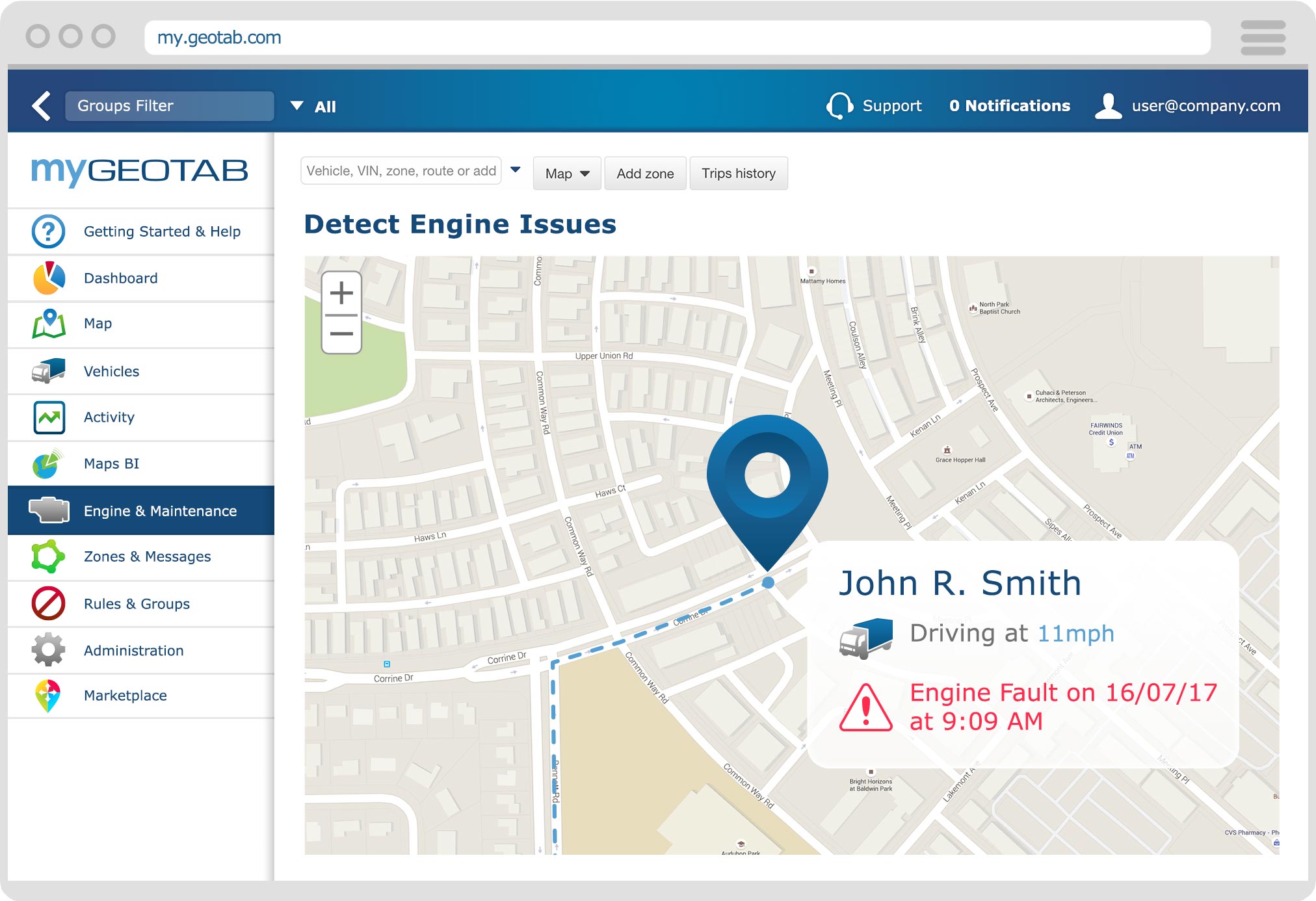
Detect engine issues in advance with telematics.
Telematics can help you protect and prolong the life of your valuable assets, or reach other goals such as idle reduction.
Case study example: A government fleet wanting to reduce carbon emissions.
10. My Employees Operate in Remote Locations (Out of Range)
You might hear someone say: A GPS tracking device and telematics solution isn’t useful because my employees work in remote locations and the data would be useless. While this may have been true in certain areas many years ago, this is no longer the case.
Technology has evolved, and continues to evolve, to provide solutions for people in remote areas of the world. While the main form of communication the Geotab GO device uses to upload data is through cellular networks, the device has the option of storing months and months of data on the device itself (which it will upload once the vehicle comes back into an area of cellular reception). So if there is no cell coverage, you won’t get the real-time data benefits, but you can still look at past data to identify trends and patterns.
Geotab also offers an Iridium option (a global satellite system), which can be used in remote areas. Instead of relying on cell towers to transmit data, the device can send data through satellites owned by Iridium Communications.
Through features like a “panic button,” oil and gas companies in remote parts of Australia are using the Iridium option to keep their employees safe. This means that a telematics device can actually increase the safety for your remote workers.
Case study example: Oil and gas fleet needing accurate data in all their remote locations.
The Final Word on Vehicle Tracking Myths
Before you make any additional assumptions about telematics, consider how much the industry has grown in recent years. If you first heard about telematics 10 years ago, then it’s likely a lot of your ideas about telematics have since changed through technology improvements or might not have been accurate in the first place.
For more information on these and other myths related to telematics, contact Geotab for more information.
More from this author:
2G Sunset Update U.S. Deadline Approaches
Originally published April 26, 2013. Updated November 8, 2017.
Subscribe to get industry tips and insights

Combining her passion for learning and discovering solutions, Stephanie Voelker works with our sales partners and customers to ensure our customers realize the highest return on their Geotab investment.
Table of Contents
- Top 10 telematics and GPS tracking myths
- 1. Telematics Means Big Brother Is Watching
- 2. A Telematics Device Will Interfere With Performance of the Car or Void the Warranty
- 3. Drivers Will Lose Driving Time
- 4. I Don’t Need to Track Dots On a Map
- 5. Telematics Is Too Expensive
- 6. My Company Is Too Small to Use Telematics
- 7. It Takes Too Much Time to Manage
- 8. Why Do I Need to Track Drivers when I Can Use Paper Logs and Service Cards?
- 9. I Trust My Employees, I Don’t Need to Track Them
- 10. My Employees Operate in Remote Locations (Out of Range)
- The Final Word on Vehicle Tracking Myths
- More from this author:
Subscribe to get industry tips and insights
Related posts

What is government fleet management software and how is it used?
April 10, 2025
3 minute read

Beyond the road: Enhancing school bus interior safety with advanced technology
April 10, 2025
5 minute read
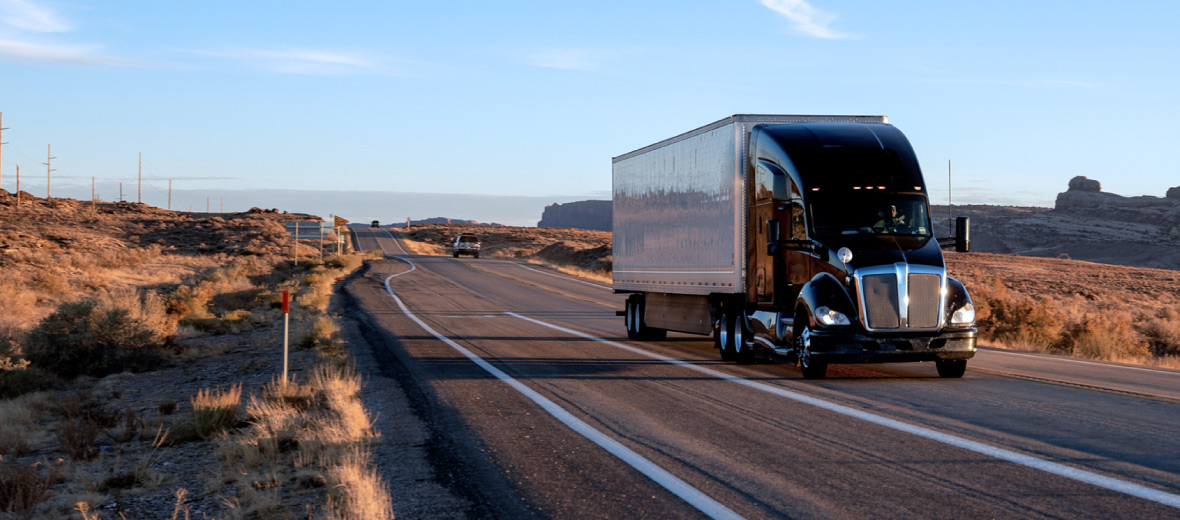
60+ trucking industry statistics: trends + outlook for 2025
April 8, 2025
6 minute read

Enhancing student bus safety: Combating distracted driving in the digital age
April 7, 2025
6 minute read

How a data driven policing environment elevates your department’s potential
March 24, 2025
4 minute read
